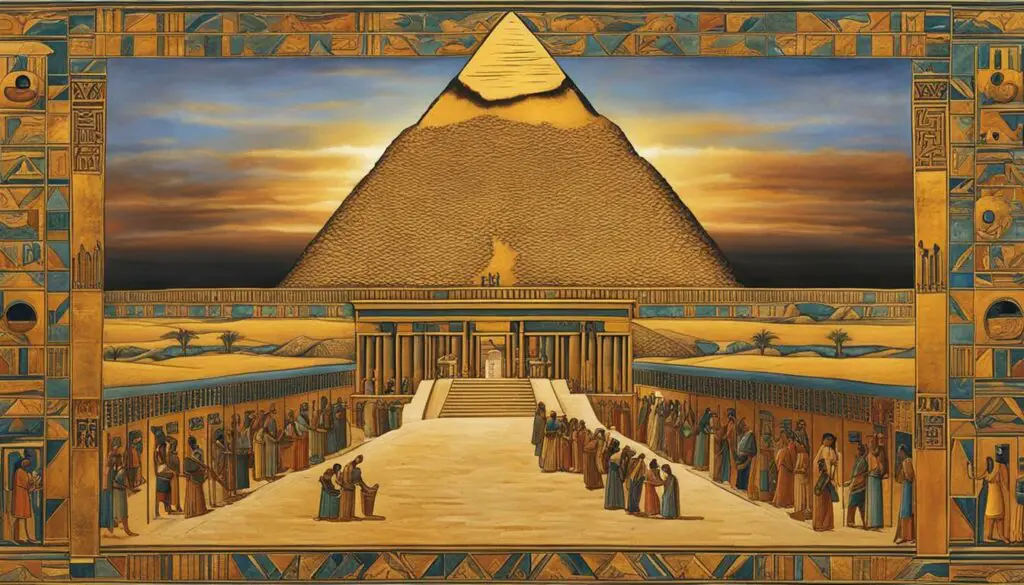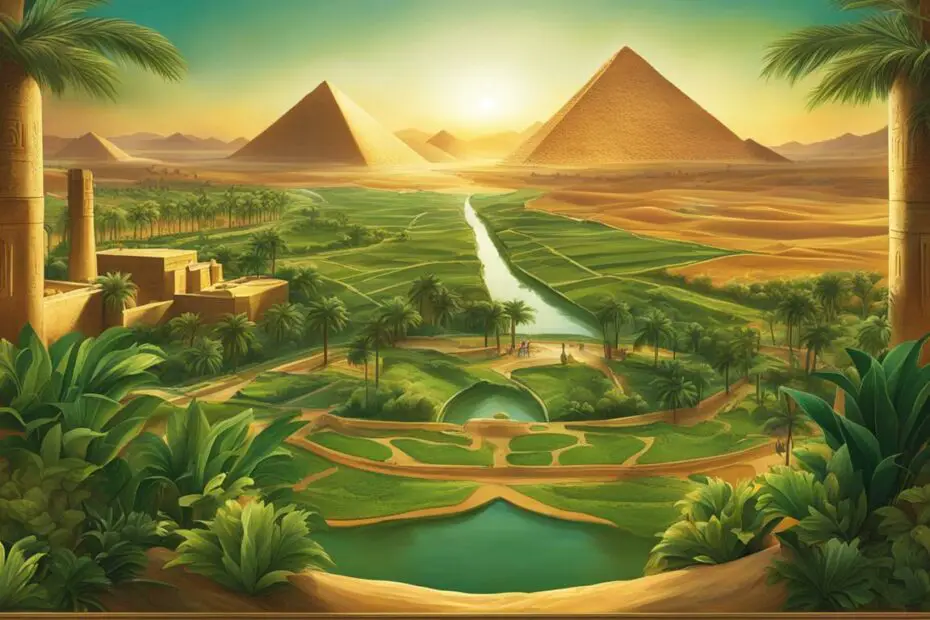The Middle Kingdom, also known as the Egyptian Middle Kingdom civilization, is often referred to as a golden age for ancient Egypt. This era, spanning from approximately 2030 to 1650 B.C., was a time of significant accomplishments and cultural developments in Egyptian history.
During the Middle Kingdom, Egypt experienced economic prosperity, political stability, and influential leadership under the rule of notable pharaohs. These factors contributed to the significance of the Middle Kingdom in shaping the history and legacy of ancient Egypt.
Understanding why the Middle Kingdom was considered a golden age involves examining its cultural and religious transformations, economic prosperity, the rule of influential pharaohs, and its eventual decline. By exploring these aspects, one can gain a comprehensive understanding of the Middle Kingdom’s contributions to Egyptian history and civilization.
Cultural and Religious Transformations in the Middle Kingdom
The Middle Kingdom of Egypt was a pivotal period characterized by significant cultural and religious transformations. Building upon the established cultural principles of early Egyptian civilization, the Middle Kingdom reimagined and reshaped various aspects of society, religion, and relationships with neighboring peoples.
Reimagining Cultural Principles
During the Middle Kingdom, there was a profound reevaluation of the ideology of kingship, which played a central role in Egyptian society. Pharaohs were not only considered political leaders but also divine rulers, responsible for the well-being of their people.
The organization of the society underwent notable changes, with an increased focus on social cohesion and the establishment of an efficient bureaucratic system. This allowed for better governance and the implementation of policies that benefited the entire kingdom.
Religious Practices and Afterlife Beliefs
The Middle Kingdom marked a shift in religious practices and afterlife beliefs. The Egyptians developed a more personal and accessible form of worship, with a greater emphasis on individual piety and direct communication with the gods.
Furthermore, the concept of the afterlife evolved during this period, with an increased emphasis on moral accountability and the judgment of the soul. It was believed that individuals would be rewarded or punished based on their actions in life, leading to the development of new funerary customs and rituals.
Relations with Neighboring Peoples
The Middle Kingdom was a time of expanding Egypt’s influence, both politically and culturally. The Egyptian pharaohs sought to establish diplomatic relations with neighboring peoples, such as the Nubians, Syrians, and Canaanites. These interactions facilitated the exchange of ideas, technology, and trade, contributing to the cultural enrichment of Egypt.
The cultural and religious transformations of the Middle Kingdom are evident in various artifacts and artistic expressions of the era. The architecture, sculpture, painting, relief decoration, stelae, jewelry, personal possessions, and literature provide valuable insights into the cultural developments that took place during this golden age of Egyptian history.

Caption: The artistic expressions of the Middle Kingdom reflect the cultural and religious transformations of the era.
Economic Prosperity in the Middle Kingdom
The Middle Kingdom of Egypt is renowned as a golden age in the country’s history, and one of the key factors contributing to its glory was the significant economic prosperity it enjoyed during this period. The rise and fall of the Middle Kingdom in Egypt were intricately tied to its economic success, which played a pivotal role in shaping its golden age status.
One of the primary drivers of economic prosperity in the Middle Kingdom was the flourishing trade along the Nile River. Trade routes, particularly with Nubia, thrived during this time, facilitating the exchange of goods and resources. Precious commodities such as ivory, ebony, leopard skins, and ostrich plumes flowed into Egypt, enriching the kingdom’s wealth.
The Middle Kingdom also witnessed the emergence of powerful nomarchs, provincial governors who played a vital role in maintaining economic stability. These nomarchs were responsible for collecting taxes and recruiting labor forces for royal projects, ensuring the smooth functioning of the kingdom’s economic infrastructure.
| Aspects of Economic Prosperity | Effects |
|---|---|
| Flourishing trade with Nubia | Increased wealth and access to valuable resources |
| Rise of powerful nomarchs | Efficient tax collection and labor recruitment for royal projects |
This economic stability and prosperity were instrumental in establishing the Middle Kingdom as a golden age for Egypt. The wealth generated through trade and taxation enabled the pharaohs to fund ambitious construction projects, engage in artistic endeavors, and strengthen the overall infrastructure of the kingdom.
The golden age of the Middle Kingdom was, therefore, intricately tied to its economic prosperity and the successful management of trade and resources. Egypt experienced unprecedented growth and cultural advancements during this period, leaving a lasting legacy in the annals of history.
Influential Pharaohs and Political Stability
The Middle Kingdom of Egypt was marked by the reign of influential pharaohs who played a vital role in maintaining political stability during this golden age. Pharaohs such as Mentuhotep II, Amenemhet I, and Senwosret III were not only powerful rulers but also ambitious visionaries who left a lasting impact on Egyptian history.
These pharaohs expanded Egypt’s territory through military campaigns, securing borders and establishing Egypt as a dominant power in the region. Their military victories brought stability and security to the kingdom, allowing for economic growth and cultural development.
Achievements in construction and architecture were also a hallmark of the Middle Kingdom, thanks to the vision and patronage of these pharaohs. They initiated major building projects, including the construction of royal tombs, temples, and irrigation systems, showcasing their grandeur and power. One notable example is Amenemhet I’s pyramid at Hawara, a monument that remains a testament to the pharaoh’s ambitious vision.
The pharaohs of the Middle Kingdom portrayed themselves as protectors and shepherds of their people. They established policies that aimed to ensure the welfare of their subjects, focusing on social justice and equitable distribution of resources. The construction of public works, such as infrastructure projects and irrigation systems, directly contributed to the prosperity and well-being of the Egyptian population.
The patronage of the arts was another key aspect of these pharaohs’ reign. They fostered a vibrant artistic culture, with their courts attracting talented artisans, sculptors, and architects. These artists produced stunning works of art that reflected the cultural and religious ideologies of the time. The Middle Kingdom’s art and craftsmanship continue to be admired for their skill, beauty, and attention to detail.
Overall, the strong leadership of pharaohs like Mentuhotep II, Amenemhet I, and Senwosret III ensured political stability in the Middle Kingdom. Their accomplishments in territorial expansion, construction, social welfare, and art patronage laid the foundation for the golden age of ancient Egypt.

Achievements of Influential Pharaohs in the Middle Kingdom
| Pharaoh | Major Accomplishments |
|---|---|
| Mentuhotep II | Reunification of Egypt, expansion of trade and influence |
| Amenemhet I | Construction of major pyramids, irrigation projects, and establishment of efficient government administration |
| Senwosret III | Successful military campaigns, expansion of Egypt’s territory, and patronage of the arts |
Legacy and Decline of the Middle Kingdom
The Middle Kingdom, also known as Egypt’s Golden Age, holds immense significance in Egyptian history. It emerged as a beacon of hope and unity after the turbulent First Intermediate Period, a time marked by political instability and disintegration. The Middle Kingdom succeeded in restoring a sense of stability and harmony to Egypt, leaving behind a lasting legacy that continues to influence subsequent periods of Egyptian civilization.
While the Middle Kingdom thrived for centuries, its golden age eventually gave way to decline. The downfall of the Twelfth Dynasty marked the beginning of the Second Intermediate Period, which ushered in foreign rule and further division within Egypt. Despite this decline, the cultural and artistic achievements of the Middle Kingdom continued to shape the course of Egyptian history.
The Middle Kingdom era witnessed remarkable advancements in various domains, including architecture, sculpture, painting, literature, and more. Its notable pharaohs, such as Mentuhotep II, Amenemhet I, and Senwosret III, led Egypt with vision and authority. They expanded Egypt’s territory, embarked on ambitious building projects, and played a pivotal role in maintaining political stability.
Today, the Middle Kingdom serves as a fascinating chapter in ancient Egypt’s history. Its recovery from turmoil, establishment of unity, and cultural achievements make it a pivotal period that contributed significantly to Egypt’s development as a civilization. The influence of the Middle Kingdom is evident in the remarkable architectural structures, exquisite artworks, and enduring cultural practices that have captured the world’s attention.
FAQ
What made the Middle Kingdom a golden age for Egypt?
The Middle Kingdom was a golden age for Egypt due to its economic prosperity, cultural developments, and the rule of influential pharaohs.
What were some cultural and religious transformations in the Middle Kingdom?
The Middle Kingdom witnessed changes in the ideology of kingship, organization of society, religious practices, afterlife beliefs, and relations with neighboring peoples.
How did economic prosperity contribute to the golden age of the Middle Kingdom?
The Middle Kingdom experienced significant economic prosperity through flourishing trade along the Nile, expansion of territory, and the rise of powerful nomarchs responsible for maintaining stability and collecting taxes.
Who were some influential pharaohs during the Middle Kingdom?
Pharaohs like Mentuhotep II, Amenemhet I, and Senwosret III played a crucial role in maintaining political stability, expanding Egypt’s territory, and patronizing the arts.
What is the legacy and decline of the Middle Kingdom?
The Middle Kingdom left a lasting legacy in Egyptian history as an ideal epoch of unity and stability. However, it eventually declined with the fall of the Twelfth Dynasty and the onset of the Second Intermediate Period, characterized by foreign rule and further division in Egypt.
